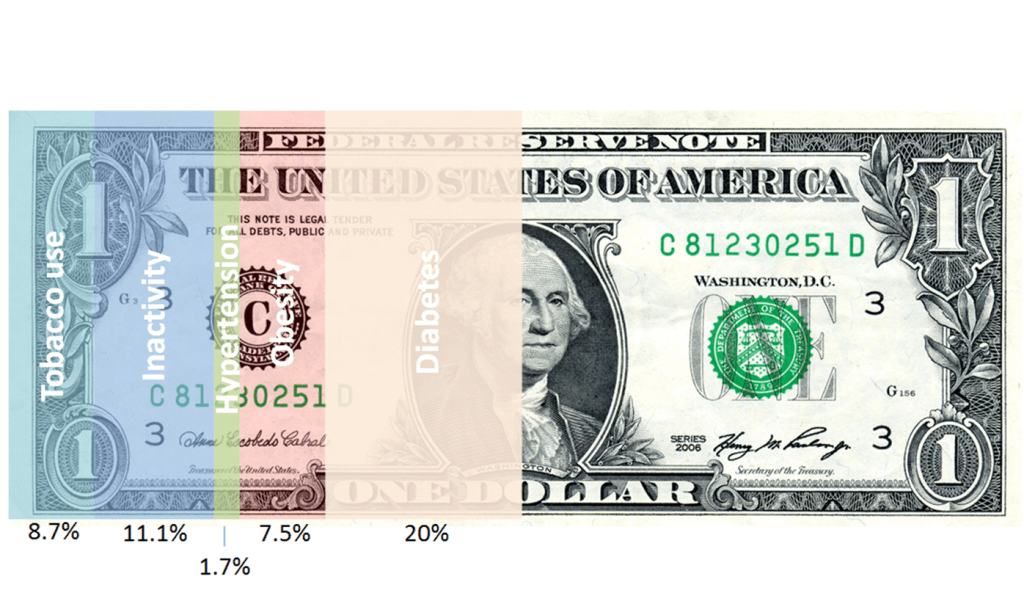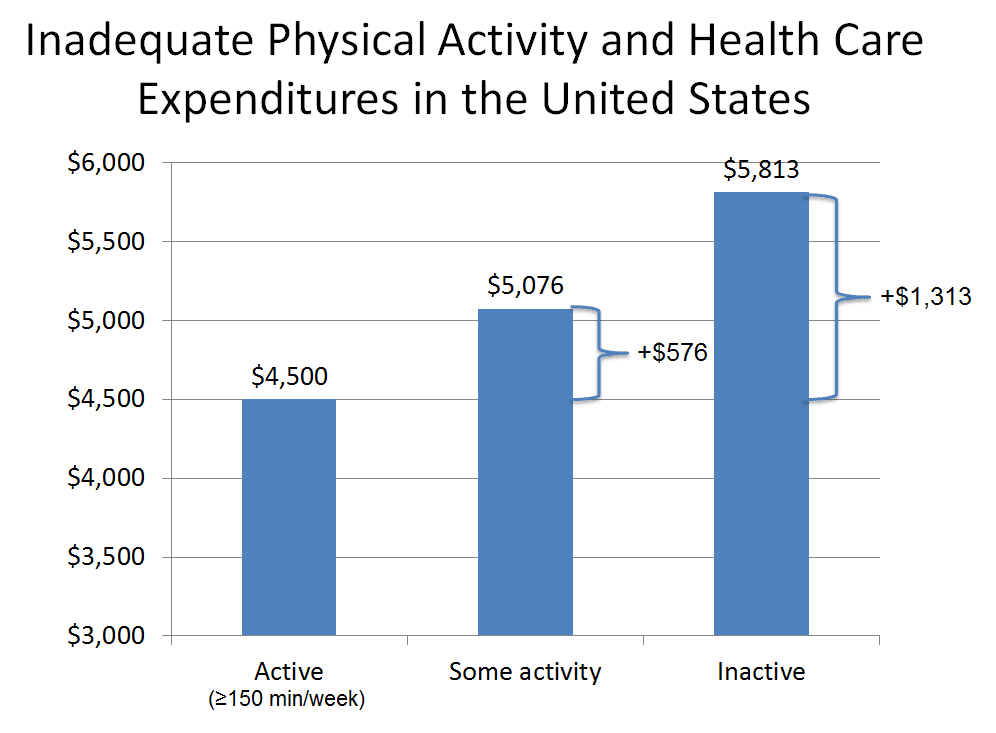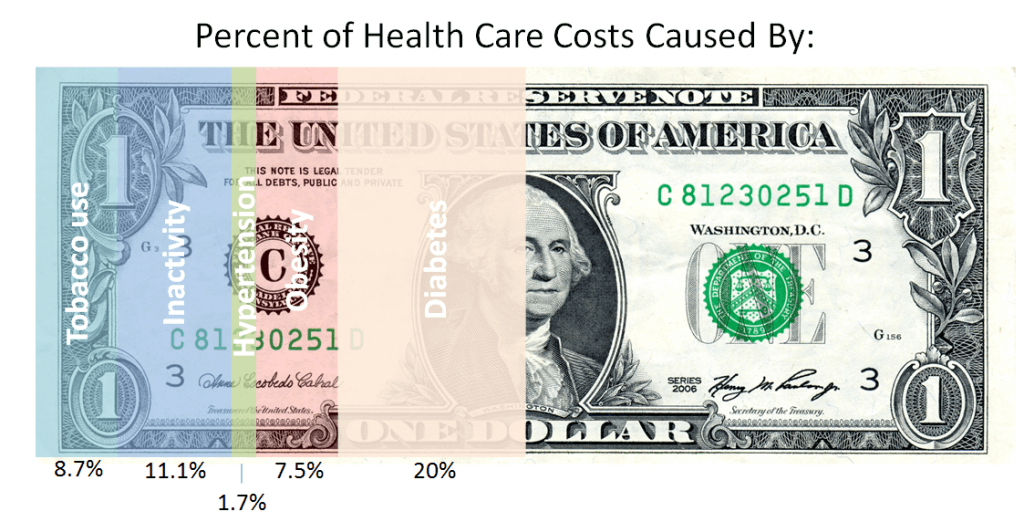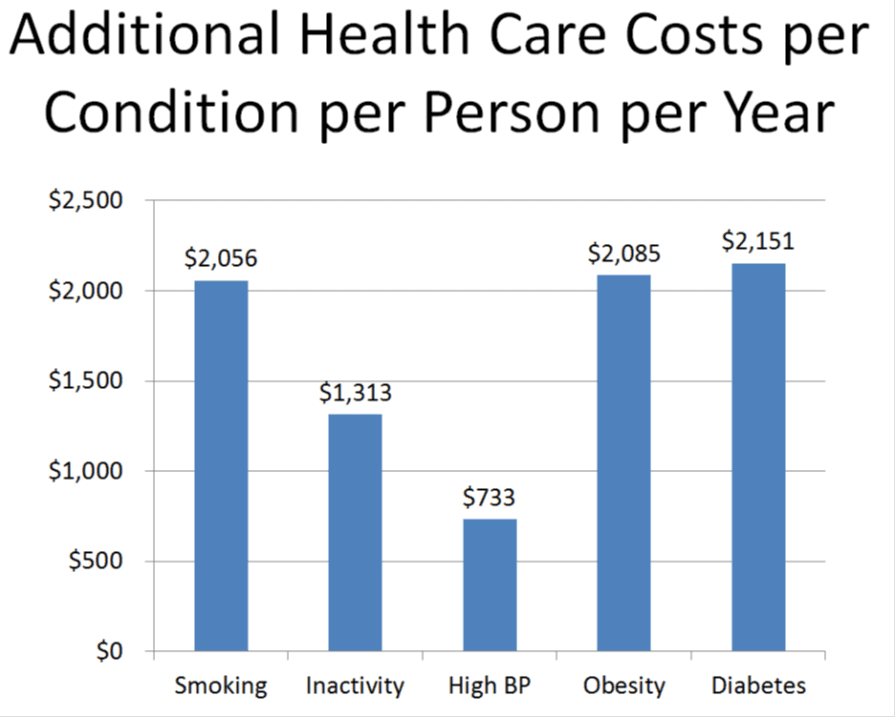This Is the Impact of Employee Wellness Programs on Health Care Costs

One of the main reasons employee wellness programs exist is to help control healthcare costs. There is a clear impact of employee wellness programs on health care costs. Today there is more scientific evidence than ever to support the ability of corporate wellness programs to improve employee health, reduce elevated health risks, and reduce healthcare costs.
These epidemiology studies use population databases to look at the relationships between health behaviors and how they are reducing healthcare costs.
They all report that unhealthy behaviors and elevated health risks are directly related to elevated health care costs. Just like the research demonstrating the dangers of cigarette smoking, none of these studies are randomized clinical trials.
The evidence reveals that most of our healthcare costs are directly related to unhealthy lifestyle choices. To understand the effect of wellness on healthcare costs, it’s important to understand how our health behaviors are directly linked to the cost of healthcare.
4 Ways to Influence the Impact of Employee Wellness Programs on Health Care Costs
Healthcare coverage is the top employee related expense for employers in the United States. As we know, healthy behaviors help control healthcare costs and unhealthy behaviors incur increased healthcare costs. For example, smoking accounts for an extra $2,056 in expenses per individual, per year – and we can all agree that smoking is unhealthy behavior. A sedentary lifestyle incurs an additional $1,313 in expenses per individual, per year. These are avoidable and could reduce small business health insurance cost, and even enterprise health care costs.
So, the question is about how to reduce health insurance cost. Well, this is where corporations both big and small turn to wellness health insurance vendors to provide incentives and encouragement to their employees.
Here are 4 ways that WellSteps helps to reduce healthcare cost through technology and other tactics:
- Online Program Center
- Rewards Activity and Incentive Tracking Tool
- Behavior Change Campaigns
- My Tracker to Help Employees Track Health Behaviors that are Syncable with many Wearables
This is just a short list of how we empower our clients to encourage healthy behaviors in the workplace.
Now, not all health issues are correlated to simple behavior changes. Take diabetes for example. It accounts for a $2,151 cost per individual, per year – but it’s not necessarily reliant on behavior changes, Type II Diabetes can be hereditary which increases the likelihood of someone developing the disease. Someone may join an organization after developing the disease and these lifestyle changes can make it more manageable, but will not completely eradicate it.
Keeping this in mind is crucial in understanding where we can reduce healthcare costs and where to expect it to stagnate.
Why Should Rising Health Care Costs Be Controlled?
Well, why shouldn’t they? If you look at the reduction in employee health care costs from either side – it’s a win-win situation. To reduce health care costs by using the impact wellness strategy – you’re not just reducing costs, you’re quite literally improving the lives of your employees. So bear in mind, this is not a scrooge magoo tactic, nor should we fault companies for aiming their sites on a reduction in fees.
On another point, when we reduce health care costs via wellness culture in the workplace, it impacts employee happiness both inside and outside of work hours. That happiness within work hours turns into increased productivity. Outside of work hours, it means better mental health and overall life satisfaction.
Benefits of Reducing Healthcare Costs
We’ve briefly touched on a few benefits of reducing healthcare costs above, but let’s dive into a few more. All in all, we really can’t think of a reason why we shouldn’t work to reduce health insurance costs. The misconception is that a reduction in fees will ultimately mean that employees are receiving less benefits – but we’ve talked about why that’s far from the truth. The idea isn’t to take away benefits, but rather to increase overall health – a commendable effort. That’s one of the best strategies to reduce healthcare costs! Wellness health insurance providers know how to control health care costs with programs and incentives that benefit the employees as much as they benefit the corporation themselves.
So, here’s a list of benefits that come from these ideas aimed to make healthcare more affordable in the US:
- Improve employee health behavior
- Reduce elevated health risks
- Reduce health care costs
- Improve productivity
- Improve employee morale
The Evidence: Healthy Behaviors Reduce Healthcare Costs
In 2016, Centers for Disease Control published a paper connecting inadequate physical activity with employee health care costs. This is just one of dozens of similar papers. To fully comprehend how powerful these studies are, here is a brief description of what they did.
The CDC researchers merged data from the National Health Interview Survey (2001-2010) and the Medical Expenditure Panel Survey. The national health interview survey uses face-to-face interviews to gather health information from individuals all around the United States.
The medical expenditure panel survey collects healthcare cost data from both federal agencies and private insurance companies. When these two data sets were merged it included information on over 58,000 individuals.
The researchers then evaluated the difference in healthcare costs between different levels of physical activity. Individuals who exercised more than 150 minutes per week spent about $4,500 per year on healthcare costs.
Those who got between zero and 150 minutes of exercise a week spent $5,076 per year and those that didn’t exercise at all spent $5,813 per year.
Understanding the Numbers of the Impact of Employee Wellness Programs on Health Care Costs
This chart shows the difference in cost according to the different levels of physical activity. Compared to those who are active, sedentary adults spend $1,313 more on health care every year.

Critics will complain that this proves nothing because it is impossible to tell which came first—high health care costs or sedentary behavior. But in this study the researchers controlled for differences in age, sex, body mass index, socioeconomic status and other confounding factors.
More importantly, the physical activity data was gathered at year one but healthcare cost claims data wasn’t used until two years after that.
Why Active and Healthy Employees are so Important for Your Business
This study is just one of many that consistently shows that the less active you are the more you spend on healthcare costs. But this study tells us even more about how wellness programs reduce healthcare costs.
The study also determined that 11.1% of the total healthcare cost of the United States was directly related to inadequate physical activity.
Let’s do some math. Last year the United States spent $3 trillion on healthcare which means physical inactivity is directly responsible for $333 billion in health care costs ($3 trillion x 11.1%).
Using other epidemiology studies (listed in references below) we can do calculations for different unhealthy behaviors. There are enormous studies that have carefully looked at the healthcare costs associated with smoking, high blood pressure, obesity, and diabetes. Each of these unhealthy behaviors is highly associated with elevated health care costs.
From these various studies this chart has been produced. It shows the total percentage of our healthcare expenditure that is directly related to each of these unhealthy behaviors.

What Are the Biggest Issues that Affect Rising Insurance Costs
Diabetes alone explains 20% of our total healthcare cost. When we include substance abuse, stress, accidents and poor nutrition the total amount of our healthcare costs that can be explained by poor lifestyle behaviors equals almost 70%.
What is not shown in the graph is the amount of overlap that exists between these different health risks. For example, many who are diabetic also don’t exercise and may have hypertension.
We don’t know the total extent of the overlap. All we know is that most healthcare expenses are related to preventable conditions.
This means that of the $3 trillion we spend on healthcare 70% of that is due to individuals eating the wrong kinds of foods, not moving around enough, using tobacco, or having other unhealthy lifestyle behaviors.
This is actually great news because it suggests that we actually have some control over this enormous expense. If most of the cost of healthcare in the United States is due to poor lifestyle choices, then helping people adopt and maintain healthy behaviors will have a direct effect to reduce health care costs in our nation.
The Annual Cost of Unhealthy Behaviors
This last chart sums it up pretty well. If you compare the healthcare cost between smokers and non-smokers the difference is about $2,056 per person per year. The difference between those who are physically active and those who are not is about $1,313 per year.
Having high blood pressure costs an additional $733 per year; if you are obese, you’re likely to spend $2,085 more than those who are not obese. And if you have diabetes, you’re going to spend $2,151 more than those who are diabetes-free.

These connections are extremely well-documented. For the skeptics out there, there is a full list of the references used to create these graphs. They are located at the bottom of this page.
The New England Journal of Medicine reported that for every 1% drop in total cholesterol, the risk of having a heart attack dropped by 2 to 3%. For every one point drop in elevated diastolic blood pressure, there is another 2 to 3% drop in heart disease risk.
As we change behaviors, we reduce elevated health risks, we reduce the likelihood of developing chronic disease, and we effectively reduce healthcare costs within our expensive healthcare system. It pretty much looks like this:

How Companies Can Use the Impact of Employee Wellness Programs on Health Care Costs
The best strategies to reduce healthcare costs are making real changes. Impact wellness of employees and encourage behavior changes. Now, it’s not always easy to change behavior, which is why approaching a wellness vendor that specializes in this matter is crucial for optimal success..
Here’s a short list on how to reduce health insurance cost with the help of WellSteps:
- Gamified behavior changing activities
- Personal Fitness Campaign with incentives
- Reward Systems
- So much more
Business health insurance cost doesn’t have to be draining – there are better ways to manage this expense. Get in touch with us for more information.
How to Reduce Cost with Wellness Programs Insurance
This figure also tells us what wellness programs need to do to be successful. It all starts with our behaviors – unhealthy behaviors and health care costs go hand in hand. Comprehensive wellness programs that follow effective behavior change strategies will improve employee health behaviors and will reduce elevated health risks and, therefore, reduce healthcare costs.
These programs will also help employees maintain these healthy behaviors for the rest of their lives. This is a pretty tall order and quite frankly, most wellness programs probably fail to produce these results.

This is why many claim that wellness programs are ineffective at reducing healthcare costs and most of these claims are probably correct. About the most difficult thing we as humans can do is to change behaviors.
Impact Wellness via Employee Lifestyle
In order for a wellness program to have any effect on healthcare costs it must be successful at helping individuals adopt and maintain healthy behaviors. We’ve covered “How to Design Wellness Programs that are Successful‘ and ‘How to Develop a Health-Contingent Wellness Program‘ – please refer to any of those blogs for further information on the topic.
What This Looks Like in the Real World
Here is an example of how a worksite used these exact steps to reduce health care costs. In this example, the 3500 employee of Boise School District participated in the WellSteps solution. Because the program was focused on behavior change, employees were able to adopt and maintain healthy behaviors.
Consequently, elevated health risks improved and reductions in health care costs were achieved. Each of these program outcomes was carefully documented in publications in peer reviewed medical journals.
The epidemiology studies discussed above suggest that poor health behaviors are strongly linked with elevated health care costs. Now we have additional proof that wellness programs that change employee behavior can reduce health care costs.
Parting Words on the Impact of Employee Wellness Programs on Health Care Costs
Corporate well-being programs that have the intention of controlling health care costs and spending must keep their programs focused on the problem: unhealthy employee behaviors. This is the only approach corporate wellness programs can take if they are to have any chance at reducing healthcare costs.

FAQs
Why Are We Not Able to Control the Costs of Healthcare?
Oh, but we are. The problem is it was previously viewed as something to cut out – or take away from employees. That’s not the right approach. Thankfully, with wellness insurance providers, like WellSteps, it’s now about improving the health of employees that in turn cuts down on health care costs.
What Are the Advantages of Cost-Sharing in Health Care?
The advantages are centered around awareness, when employees are aware of the costs associated with a health care plan, they’re more likely to be cautious of spending.
How Much Will it Cost a Business to Provide Health Insurance for Employees?
Small firms that house below 200 employees paid approximately $14,000 for family coverage and $8,000 for single coverage in 2020 according to the 2020 Kaiser Family Foundation Report.
How to Reduce Health Insurance Cost
The best way to reduce health insurance cost is by improving the health of your employees. This can be done via wellness vendors that specialize in the areas of behavior change with incentives, rewards, and tool tracking software. When considering how to control health care costs, cutting the expenses simply won’t do the trick. Scroll up to learn more about how to cut healthcare costs.
Are the Best Ways to Reduce Cost of Healthcare through Wellness Programs Insurance?
Yes – the other alternative would be to cut down expenses by simply, well, cutting business health insurance cost out. What this does to employee morale and corporate image is enough to turn companies away from the idea. Improving employee health, on the other hand, will increase productivity, boost employee morale, and create a corporate image that attracts talent.
SUBSCRIBE TO THIS BLOG
REFERENCES
Health, Life Expectancy, and Health Care Spending among the Elderly
http://www.nejm.org/doi/pdf/10.1056/NEJMsa020614
Inadequate Physical Activity and Health Care Expenditures in the United States
https://www.cdc.gov/nccdphp/dnpao/docs/carlson-physical-activity-and-healthcare-expenditures-final-508tagged.pdf
Higher Health Care Costs with Obesity
https://www.hsph.harvard.edu/obesity-prevention-source/obesity-consequences/economic/
Medical Cost of Overweight and Obesity
https://www.ncbi.nlm.nih.gov/pmc/articles/PMC2891924/
The Lifetime Cost of Diabetes and Its Implications for Diabetes Prevention
http://care.diabetesjournals.org/content/37/9/2557
Hypertension and Health Care Costs:
https://meps.ahrq.gov/data_files/publications/st404/stat404.shtml
Annual Healthcare Spending Attributable to Cigarette Smoking
https://www.ncbi.nlm.nih.gov/pmc/articles/PMC4603661/
Estimating the Cost of a Smoking Employee
http://tobaccocontrol.bmj.com/content/early/2013/05/25/tobaccocontrol-2012-050888






Dr. Aldana:
When productivity loss and extra absent days are included, the CDC claims workplace smoking costs $192.5 billion every year- $5800 per smoker.
When workplace smoking is “managed”; the efficacy outcomes and the reduced absent days and elimination of lost productivity combine to produce a 10X+ annual return for employers’.